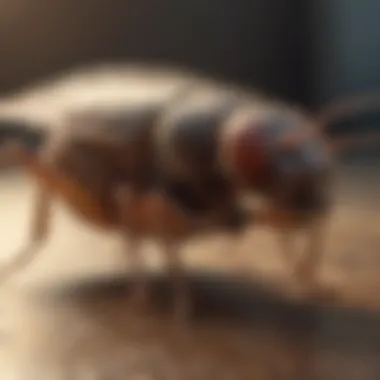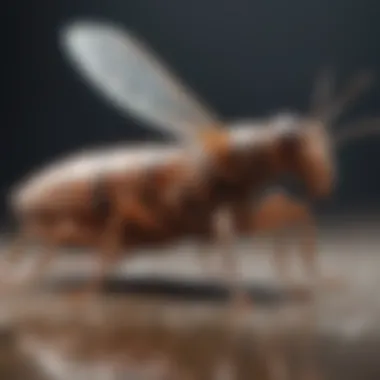Expert Strategies for Eliminating Fleas from Your Home Easily


Preventive Pest Control Strategies
When it comes to maintaining a pest-free environment in your home, implementing proactive preventive pest control strategies is paramount. Beginning with safeguarding your house's exterior, it's essential to focus on sealing cracks that could serve as entry points for pests. Clearing debris in your yard is equally important as it eliminates hiding spots for unwanted visitors. Moreover, taking steps to prevent pests from entering your home, such as installing proper screens on doors and windows, can significantly reduce the chances of infestations.
Yard maintenance plays a crucial role in pest prevention. Regularly engaging in essential yard care routines like mowing the lawn, trimming bushes, and removing standing water helps to deter pests from making your yard their home. Implementing methods to keep your yard pest-free, such as using natural repellents or eco-friendly sprays, adds an extra layer of protection.
Maintaining indoor cleanliness is key to preventing pests from thriving in your living spaces. Expert cleaning tips and techniques, like vacuuming regularly, eliminating clutter, and sealing food containers, are effective in deterring pests. Creating a pest-resistant indoor environment through proper sanitation practices and timely repairs reduces the likelihood of infestations.
Efficient garbage disposal is vital in pest control. Implementing proper waste disposal methods, such as using tightly sealed trash bins and disposing of garbage regularly, not only keeps your surroundings clean but also eliminates food sources that attract pests. Emphasizing the importance of proper garbage disposal to all household members is essential in maintaining a pest-free home.
In addition to the above preventive strategies, exploring innovative ways to safeguard your home from pests, such as using natural deterrents like cedar wood or diatomaceous earth, can further fortify your defenses against infestations. By incorporating a combination of these preventive pest control strategies, you can create a hostile environment for pests and protect your home effectively.
Understanding Fleas
Understanding fleas is paramount when it comes to eradicating these pesky pests from your home effectively. In this article, we delve into the intricate details of fleas, their life cycle, impact on health, and signs of infestation. By comprehensively understanding fleas, you empower yourself to take targeted actions to eliminate them completely.
Introduction to Fleas
Fleas, small wingless insects of the order Siphonaptera, are formidable adversaries in the battle against household pests. Their minuscule size belies the havoc they can wreak on both humans and animals. By comprehensively understanding fleas, you can strategize an effective plan to combat them. From their feeding habits to breeding grounds, every aspect of fleas is crucial in comprehending how to rid your home of these nuisances.
What are fleas?
Delving into the definition of fleas unveils a world of intricate biological mechanisms that allow these tiny creatures to thrive. Identifying the key characteristics of fleas, such as their specialized mouthparts for blood-feeding, sheds light on why they are challenging to eradicate. Understanding the unique feature of fleas, their incredible jumping ability, underscores the agility and resilience that make them a formidable opponent in the battle for a flea-free environment.
Flea life cycle
A deep dive into the flea life cycle reveals the stages of development that contribute to their persistent presence. Highlighting the characteristics of each stage, from egg to larva to pupa and adult, illuminates the complexity of eradicating fleas completely. Understanding the advantages and disadvantages of each stage in the context of flea elimination provides a strategic advantage in combatting infestations.
Impact of fleas on health
The impact of fleas on health extends beyond simple nuisance; these tiny creatures can transmit diseases and cause discomfort to both humans and animals. By understanding the potential risks associated with flea bites, you gain insight into the urgency of eliminating them. Recognizing the signs of flea infestation signals the need for immediate action to safeguard your family and pets.
Signs of flea infestation


Identifying the signs of flea infestation is critical in preventing widespread infestations. From the presence of flea dirt on pets to unusual red bites on humans, recognizing these indicators early can prevent a full-blown infestation. By acknowledging the unique features of flea infestation signs, you position yourself to tackle the problem proactively and effectively.
Common Sources of Fleas
Understanding the common sources of fleas plays a pivotal role in devising preventive strategies to keep them at bay. Pets, outdoor exposure, and human transportation are key factors in the spread of fleas within a household. By exploring these sources in depth, you gain insight into how fleas infiltrate your living spaces and how to disrupt their breeding and feeding grounds.
Pets as carriers
Pets, beloved members of the family, can unwittingly function as carriers of fleas into your home. Understanding the key characteristics of pets as carriers, such as their susceptibility to flea infestations and grooming habits, enables you to implement targeted prevention measures. Recognizing the advantages and disadvantages of pets as carriers equips you with the knowledge to protect your furry companions and your home.
Outdoor exposure
The great outdoors may harbor unseen threats in the form of fleas waiting to hitch a ride into your home. Highlighting the key characteristics of outdoor exposure, such as common hiding spots for fleas and transmission vectors, reveals the extent of potential flea invasion. Understanding the unique feature of outdoor exposure emphasizes the importance of outdoor precautions in preventing flea infestations.
Human transportation
Humans can unwittingly become carriers of fleas, transporting these pests from one location to another. Discussing the key characteristics of human transportation, including how fleas hitchhike on clothing and belongings, sheds light on this potential entry point for infestations. Understanding the advantages and disadvantages of human transportation underscores the need for vigilance in preventing accidental flea introductions into your home.
Preventive Measures
Maintaining Cleanliness
Regular Vacuuming
Regular vacuuming plays a pivotal role in flea control within your home. By vacuuming your floors, carpets, and furniture regularly, you can remove flea eggs, larvae, and adult fleas. This not only reduces the flea population but also eliminates their breeding grounds. The suction power of a vacuum cleaner captures fleas at various stages of their life cycle, aiding in breaking the infestation cycle. Regular vacuuming is a recommended practice to diminish the flea population in your home efficiently.
Washing Bedding and Pet Accessories
Washing bedding and pet accessories is instrumental in eliminating fleas and their eggs. Fleas often hide in fabrics like bedding, pet beds, and blankets, making regular washing essential. By laundering these items in hot water, you can kill fleas and prevent reinfestation. This practice not only targets adult fleas but also disrupts their reproductive cycle by eliminating eggs and larvae present in fabrics.
Clutter Control
Maintaining clutter-free living spaces is essential in flea prevention. Clutter provides hiding spots for fleas and makes it challenging to locate and eliminate them. By organizing and decluttering your home, you can eliminate potential flea habitats and make it easier to spot and treat infested areas. Simplifying your living spaces reduces the chances of flea infestations and allows for effective pest control measures.


Pet Care Practices
Flea Prevention Products
Flea prevention products such as topical treatments, collars, and oral medications are vital in protecting your pets from fleas. These products contain active ingredients that repel and kill fleas upon contact, preventing infestations. Selecting the right flea prevention product based on your pet's needs and lifestyle is essential for effective protection. Incorporating these products into your pet care routine ensures continuous defense against fleas.
Regular Grooming
Regular grooming of pets is an essential aspect of flea control. Grooming helps in early detection of fleas or flea dirt on your pet's fur, enabling prompt treatment. Brushing and combing your pet's hair not only aid in removing adult fleas but also enhance blood circulation, promoting healthy skin and coat. By incorporating regular grooming sessions into your pet care regimen, you can mitigate the risk of flea infestations.
Outdoor Precautions
Taking outdoor precautions is crucial in preventing fleas from entering your home. Fleas can hitch a ride on your pet's fur or clothing when outdoors, leading to infestations indoors. By checking your pet for fleas after outdoor activities, you can prevent them from bringing fleas inside. Regularly grooming and inspecting your pet for signs of fleas before re-entering your home helps in early detection and prevention of infestations.
Natural Remedies
In the quest to eradicate fleas from your home, exploring natural remedies is a crucial aspect. Natural remedies offer a non-toxic and environmentally friendly alternative to chemical treatments, making them particularly appealing to individuals concerned about the health of their families and pets. The benefits of natural remedies extend beyond flea elimination, as they also help in creating a safe and healthy living environment for everyone. By incorporating natural remedies into your flea control routine, you can address the infestation while minimizing the risks associated with harsh chemicals commonly found in traditional treatments.
Essential Oils
Lavender oil
Lavender oil stands out as a prominent player in the realm of natural flea remedies. Its gentle yet potent properties make it a popular choice for combating fleas while providing a pleasant aroma. Lavender oil is known for its calming effects, which can be advantageous in creating a soothing atmosphere in your home while battling flea infestations. However, it is essential to note that some individuals may be sensitive to strong scents, so moderation in usage is key to avoiding any potential drawbacks.
Eucalyptus oil
Eucalyptus oil is another valuable weapon in the fight against fleas. Its strong scent acts as a natural repellent, deterring fleas from infesting your living spaces. Additionally, eucalyptus oil possesses antibacterial and antifungal properties, adding an extra layer of protection for your home. While eucalyptus oil is highly effective in repelling fleas, some pets may be sensitive to its powerful aroma, requiring careful application to prevent any adverse reactions.
Lemongrass oil
Lemongrass oil offers a dual benefit of flea control and air purification. Its fresh and citrusy scent not only repels fleas but also leaves your home smelling clean and refreshing. Lemongrass oil's natural insect-repellent properties make it an attractive choice for individuals seeking a chemical-free solution to flea infestations. However, as with any essential oil, it's essential to dilute lemongrass oil properly to prevent skin irritation and ensure safe usage in a household with pets or children.
Diatomaceous Earth


Usage instructions
Integrating diatomaceous earth into your flea control regimen requires careful attention to usage instructions. This powdery substance should be applied in thin layers across flea-prone areas, such as carpets, pet bedding, and crevices where fleas hide. The abrasive nature of diatomaceous earth works by dehydrating and ultimately killing fleas upon contact, making it a natural and effective solution for flea eradication.
Effectiveness
Diatomaceous earth's effectiveness lies in its ability to target and eliminate fleas at various life stages. This natural mineral compound is non-toxic to humans and pets, offering a safe alternative for households with concerns about chemical exposure. While diatomaceous earth can be a potent tool in flea control, consistency in application and thorough coverage of infested areas are critical for maximizing its effectiveness and achieving long-term flea prevention.
Professional Treatments
Professional treatments play a crucial role in the comprehensive guide to eliminating fleas from your home. These treatments are essential for effectively eradicating fleas and ensuring a flea-free environment for you and your family. Professional treatments encompass a range of specialized methods and products that target fleas at different stages of their life cycle. By entrusting the extermination process to trained professionals, you can benefit from their expertise and access to potent solutions that may not be available over the counter.
Extermination Services
Extermination services are a key component of professional treatments, offering targeted solutions to combat flea infestations effectively. The use of insecticide sprays, fogging treatments, and follow-up procedures are common practices in professional extermination services. Each method is designed to address specific aspects of flea control, from immediate eradication to long-term prevention.
Insecticide Sprays
Insecticide sprays are a fundamental tool in flea extermination, delivering potent chemicals to eliminate adult fleas and disrupt their reproductive cycle. The key characteristic of insecticide sprays is their quick action and residual effect, which continues to combat fleas even after the initial application. This makes them a popular choice for homeowners seeking fast and effective results. However, it is essential to consider the potential risks associated with chemical exposure and ensure proper application techniques to maximize their benefits.
Fogging Treatments
Fogging treatments involve the dispersion of insecticidal fog throughout the indoor environment to reach hidden areas where fleas may reside. The key characteristic of fogging treatments is their ability to cover large spaces and penetrate crevices that are hard to reach with traditional sprays. This thorough method makes fogging treatments a preferred choice for comprehensive flea eradication. Despite their effectiveness, fogging treatments require careful planning to ensure the safety of humans and pets during the application process.
Follow-Up Procedures
Follow-up procedures are essential in maintaining the efficacy of professional treatments over time. These procedures may involve repeat applications of insecticide sprays or scheduling regular inspections to monitor for the resurgence of fleas. The key characteristic of follow-up procedures is their proactive approach to prevent re-infestations and ensure long-term success in flea control. By adhering to these measures, homeowners can enjoy a sustained flea-free environment and peace of mind.
Consulting Pest Control Experts
Consulting pest control experts provides valuable insights and tailored solutions to address specific challenges related to flea infestations. Pest control experts offer professional assessments of infestations and develop personalized treatment plans based on the severity of the problem and the unique characteristics of the home environment. By relying on their expertise, homeowners can benefit from targeted strategies that are customized to their needs.
Assessment of Infestation
The assessment of infestation is a critical step in determining the extent of the flea problem and identifying key areas of intervention. Pest control experts use advanced techniques to survey the premises, locate flea hotspots, and assess the underlying factors contributing to the infestation. The key characteristic of assessment is its diagnostic nature, allowing experts to formulate precise treatment protocols that target the source of the infestation. However, it is important to engage with reputable professionals to ensure accurate assessments and effective treatment outcomes.
Tailored Treatment Plans
Tailored treatment plans are personalized strategies developed by pest control experts to address the specific needs of each household. These plans take into account factors such as the presence of pets, the severity of infestation, and the homeowner's preferences regarding treatment methods. The key characteristic of tailored treatment plans is their customized approach, which ensures that interventions are aligned with the unique circumstances of the infested property. By implementing tailored treatment plans, homeowners can achieve optimal results in flea eradication and prevent future infestations.



